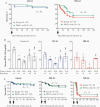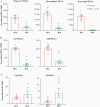Anti-PD-L1 Therapy Does Not Improve Survival in a Murine Model of Lethal Staphylococcus aureus Pneumonia
- PMID: 34009385
- PMCID: PMC8672766
- DOI: 10.1093/infdis/jiab274
Anti-PD-L1 Therapy Does Not Improve Survival in a Murine Model of Lethal Staphylococcus aureus Pneumonia
Abstract
Background: Staphylococcus aureus (SA) bacterial pneumonia is a common cause of sepsis in intensive care units. Immune checkpoint inhibitors (CPIs) that target programmed cell death protein 1 (PD-1) and its ligand (PD-L1) have been proposed for the treatment of sepsis. However, in our systematic review of sepsis preclinical models, none of the models examined CPIs in pneumonia.
Methods: Mice were inoculated intratracheally with vehicle control, low dose (LD)- or high dose (HD)-SA. Immune cell recruitment and checkpoint molecule expression were examined at 4, 24, and 48 hours after infection. Infected animals, treated with control or anti-PD-L1 antibodies, were assessed for survival, bacterial burden, lung immunophenotypes, and mediator production.
Results: LD-SA and HD-SA produced lethality of 15% and 70%, respectively, by 168 hours. At 24 hours, LD-infected animals exhibited increased lung monocyte PD-L1 expression (P = .0002) but lower bacterial counts (P = .0002) compared with HD animals. By 48 hours, either infection induced lung neutrophil and macrophage PD-L1 expression (P < .0001). Anti-PD-L1 treatment at the time of infection and at 24 hours following infection with low to high doses of SA reduced PD-L1 detection but did not affect survival or bacterial clearance.
Conclusions: Anti-PD-L1 therapy did not alter survival in this pneumonia model. Preclinical studies of additional common pathogens and septic foci are needed.
Keywords: Staphylococcus aureus; immunotherapy; pneumonia; sepsis.
Published by Oxford University Press for the Infectious Diseases Society of America 2021.
Figures






Similar articles
-
Anti-PD-L1 therapy altered inflammation but not survival in a lethal murine hepatitis virus-1 pneumonia model.Front Immunol. 2024 Jan 8;14:1308358. doi: 10.3389/fimmu.2023.1308358. eCollection 2023. Front Immunol. 2024. PMID: 38259435 Free PMC article.
-
Frontline Science: Anti-PD-L1 protects against infection with common bacterial pathogens after burn injury.J Leukoc Biol. 2018 Jan;103(1):23-33. doi: 10.1002/JLB.5HI0917-360R. Epub 2017 Dec 21. J Leukoc Biol. 2018. PMID: 29345058 Free PMC article.
-
PD-L1 blockade improves survival in experimental sepsis by inhibiting lymphocyte apoptosis and reversing monocyte dysfunction.Crit Care. 2010;14(6):R220. doi: 10.1186/cc9354. Epub 2010 Nov 30. Crit Care. 2010. PMID: 21118528 Free PMC article.
-
Safety and Efficacy of PD-1/PD-L1 inhibitors combined with radiotherapy in patients with non-small-cell lung cancer: a systematic review and meta-analysis.Cancer Med. 2021 Feb;10(4):1222-1239. doi: 10.1002/cam4.3718. Epub 2021 Jan 19. Cancer Med. 2021. PMID: 33465302 Free PMC article.
-
PD-1/PD-L1 Blockade Therapy in Advanced Non-Small-Cell Lung Cancer: Current Status and Future Directions.Oncologist. 2019 Feb;24(Suppl 1):S31-S41. doi: 10.1634/theoncologist.2019-IO-S1-s05. Oncologist. 2019. PMID: 30819829 Free PMC article. Review.
Cited by
-
The implication of targeting PD-1:PD-L1 pathway in treating sepsis through immunostimulatory and anti-inflammatory pathways.Front Immunol. 2023 Dec 13;14:1323797. doi: 10.3389/fimmu.2023.1323797. eCollection 2023. Front Immunol. 2023. PMID: 38193090 Free PMC article. Review.
-
PD-L1 Antibody Pharmacokinetics and Tumor Targeting in Mouse Models for Infectious Diseases.Front Immunol. 2022 Mar 10;13:837370. doi: 10.3389/fimmu.2022.837370. eCollection 2022. Front Immunol. 2022. PMID: 35359962 Free PMC article.
-
A comparative 18F-FDG and an anti-PD-L1 probe PET/CT imaging of implant-associated Staphylococcus aureus osteomyelitis.Front Cell Infect Microbiol. 2023 May 24;13:1182480. doi: 10.3389/fcimb.2023.1182480. eCollection 2023. Front Cell Infect Microbiol. 2023. PMID: 37293208 Free PMC article.
-
Resolving sticky relationships between platelets and lymphocytes in COVID-19: A role for checkpoint inhibitors?Br J Haematol. 2022 May;197(3):247-249. doi: 10.1111/bjh.18095. Epub 2022 Mar 4. Br J Haematol. 2022. PMID: 35132612 Free PMC article. No abstract available.
-
Anti-PD-L1 therapy altered inflammation but not survival in a lethal murine hepatitis virus-1 pneumonia model.Front Immunol. 2024 Jan 8;14:1308358. doi: 10.3389/fimmu.2023.1308358. eCollection 2023. Front Immunol. 2024. PMID: 38259435 Free PMC article.
References
-
- van Vught LA, Klein Klouwenberg PM, Spitoni C, et al. . MARS Consortium . Incidence, risk factors, and attributable mortality of secondary infections in the intensive care unit after admission for sepsis. JAMA 2016; 315:1469–79. - PubMed
-
- Jin HT, Ahmed R, Okazaki T. Role of PD-1 in regulating T-cell immunity. Curr Top Microbiol Immunol 2011; 350:17–37. - PubMed
-
- Kinter AL, Godbout EJ, McNally JP, et al. . The common gamma-chain cytokines IL-2, IL-7, IL-15, and IL-21 induce the expression of programmed death-1 and its ligands. J Immunol 2008; 181:6738–46. - PubMed
Publication types
MeSH terms
Substances
LinkOut - more resources
Full Text Sources
Other Literature Sources
Medical
Research Materials

